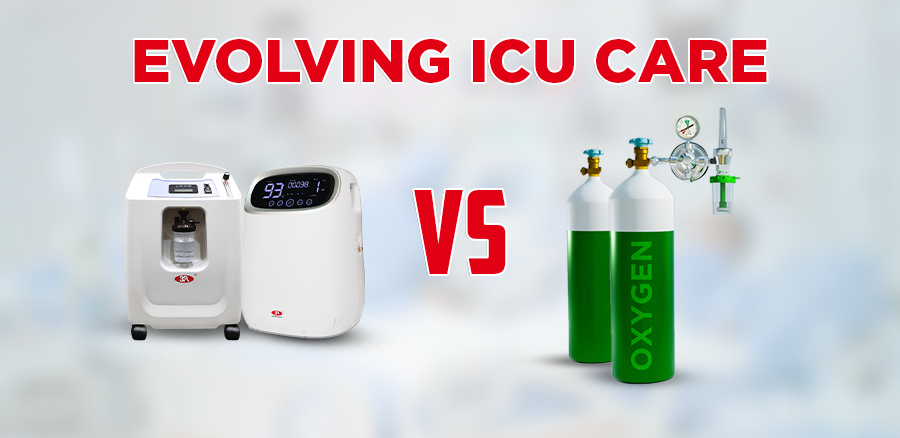The field of healthcare is continuously evolving with advancements that improve patient outcomes and quality of life. Oxygen therapy is a critical component of the care provided to patients in the ICU. It is used to treat various respiratory illnesses and conditions, such as chronic obstructive pulmonary disease (COPD), pneumonia, and acute respiratory distress syndrome (ARDS).
Oxygen therapy is delivered using either oxygen cylinders or oxygen concentrators. Oxygen cylinders are the traditional method used for oxygen therapy, while oxygen concentrators are a relatively new technology. With advancements in technology, oxygen concentrators have become more prevalent in healthcare settings.
In recent years, medical researchers have been focusing on enhancing respiratory care methods, especially for critically ill patients in the Intensive Care Unit (ICU). One such development is the use of oxygen concentrators as opposed to traditional oxygen cylinders. A groundbreaking study published in the journal “Respiratory Care” in 2017 provided valuable insights into the benefits of oxygen concentrators for ICU patients, demonstrating a lower risk of pneumonia and a reduced length of stay in the ICU.
Understanding Oxygen Concentrators vs Oxygen Cylinders
Photo by Mufid Majnun on Unsplash
Before delving into the research findings, it’s essential to understand the fundamental differences between oxygen concentrators and oxygen cylinders. Both these devices deliver oxygen to patients, but they function differently.
Oxygen Cylinders in ICU
Oxygen cylinders contain compressed oxygen gas and require regular refilling. They are portable and can provide oxygen on-demand, but they need careful monitoring to prevent running out of oxygen unexpectedly.
Oxygen Concentrators in ICU
In contrast, oxygen concentrators are electrical devices that draw in room air and use sophisticated filtering and concentration techniques to deliver a continuous flow of oxygen to patients. They are more convenient for long-term use as they don’t require refilling, only access to a power source.
The Study: A Game-Changer for ICU Care
Photo by Sander Sammy on Unsplash
The study published in “Respiratory Care” sought to compare the outcomes of ICU patients using either oxygen concentrators or oxygen cylinders. The research team conducted a comprehensive analysis, considering factors such as the risk of pneumonia and the length of ICU stay.
Lower Risk of Pneumonia
Pneumonia is a serious concern for ICU patients, particularly those with compromised respiratory function. The study’s findings revealed that patients treated with oxygen concentrators had a significantly lower risk of developing pneumonia compared to those using oxygen cylinders. This remarkable outcome can be attributed to the consistent and regulated oxygen flow provided by concentrators, which optimizes lung function and reduces the chances of respiratory infections.
The study’s results not only highlight the benefits of oxygen concentrators but also underscore the importance of maintaining adequate oxygenation in ICU patients. Proper oxygen therapy not only aids in preventing pneumonia but also plays a crucial role in overall patient recovery.
Shorter Length of ICU Stay
The length of stay in the ICU is an essential indicator of patient recovery and resource utilization. The study found that patients treated with oxygen concentrators experienced a notably shorter length of stay in the ICU compared to those using oxygen cylinders. This finding suggests that the use of oxygen concentrators can expedite the recovery process, enabling patients to be transferred to regular hospital wards or discharged home sooner.
The shorter ICU stay not only improves patient comfort and well-being but also helps alleviate the burden on healthcare facilities and resources. Hospitals can better manage patient flow and optimize bed availability, which is especially crucial during times of increased demand.
Implications for Critical Care Practices
Photo by Sander Sammy on Unsplash
The research’s implications are significant for critical care practices worldwide. The adoption of oxygen concentrators as a preferred method of oxygen delivery in the ICU can revolutionize patient care and outcomes. Here are some key takeaways from the study:
Enhanced Patient Safety
The reduced risk of pneumonia associated with oxygen concentrators can lead to better patient safety and outcomes. By minimizing the occurrence of preventable complications, medical professionals can focus on other aspects of patient care and recovery.
Improved Resource Management
The study’s finding of a shorter length of ICU stay with oxygen concentrators can contribute to better resource management within healthcare facilities. By discharging patients earlier or transferring them to regular wards promptly, hospitals can optimize bed utilization and allocate resources more efficiently.
Cost-Effectiveness
Oxygen concentrators’ cost-effectiveness compared to oxygen cylinders makes them an attractive choice for healthcare facilities aiming to provide quality care while managing their budget effectively.
Convenience and Mobility
Oxygen concentrators offer the advantage of continuous oxygen flow without the need for constant refilling of cylinders. This feature enhances patient mobility and comfort, allowing them to move more freely within the hospital premises.
What are You Going to Choose For Your Patients?
Oxygen concentrators offer numerous benefits in terms of reduced infection risk, more control over oxygen delivery, cost-effectiveness, and increased mobility. Oxygen concentrators are an effective method for delivering oxygen therapy in the ICU and have the potential to improve patient outcomes and enhance healthcare efficiency. As with any medical technology, it is important to work with a qualified healthcare provider to determine the best approach for each patient’s individual care.
As medical science progresses, it is essential for healthcare professionals and institutions to stay abreast of these advancements. The adoption of medical oxygen concentrators can be a game-changer in ICU patient care, leading to improved patient outcomes, enhanced resource management, and ultimately, better overall healthcare provision. By incorporating these findings into clinical practices, medical professionals can continue to strive for excellence in critical care and pave the way for a healthier and brighter future for their patients.If you want to learn more about oxygen concentrators or want to know where you can see more details about them, browse our website!

